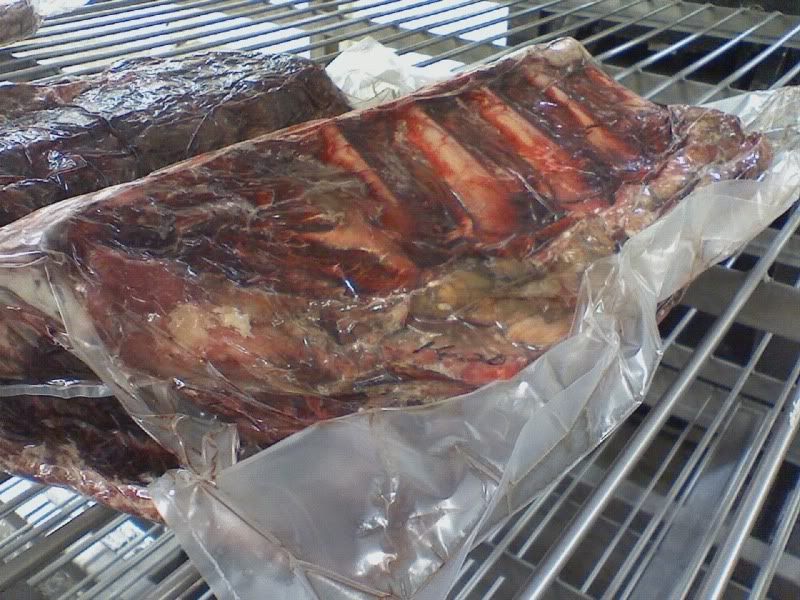The Original Dry Bag Steak | Make Artisan Dry Age Steak at Home › Forums › Dry Aging Steak › Dry Aging Steak with UMAi Dry® › Bone-In Ribeye
- This topic has 3 replies, 3 voices, and was last updated 13 years, 11 months ago by
Thea.
-
AuthorPosts
-
June 3, 2011 at 2:45 am #1247
Jeff S
MemberI’m thinking of dry aging an approximately 15 lb, bone-in 8 bone Prime Rib.
I was wondering if anyone here has tried using the bags for a bone-in piece of beef? If so, did it work well?
I was also hoping someone would be able to tell me which size bag I will need for this. I know a boneless ribeye fits in the subprimal bag, but do you think I will need the brisket-sized bag for a bone-in cut?
Thanks,
Jeff
June 3, 2011 at 1:38 pm #4764Ron Pratt
MemberJeff,
For size you are correct it would be best to go with the large brisket size bag. The issue though is aging a bone-in sub-primal. In essence you will only be subjecting half of the meat to the benefit of the DrybagSteak technology since the bone will prevent the give up of moisture. There is also the risk that the bone will puncture the bag upon sealing. Granted, commercial shops which age beef in their controlled environment rooms will leave the bone in but that is mainly to limit trimming loss. Since you are just going to toss the bone anyway then why not start with a boneless piece and receive full benefit?
Ron
June 4, 2011 at 11:40 am #4765Jeff S
MemberIt has been my experience that Bone-In steaks, specifically Ribeyes are infinitely more flavorful than boneless ones. Also, some of the tastiest, most tender meat you get when cooking a ribeye comes from right off the bone, and if you ask the butcher to remove those bones, you will be losing that meat.
Being that 3 of the 4 faces of the ribeye (top, left, and right) will still be exposed to the air, and my refrigerator has excellent circulation, I don’t think the effect on the drying process will be all that noticeable… I still think I will have more than enough moisture loss / concentration of flavor.
Have you actually tried a bone-in to see what the difference would be? Or are you just postulating?
June 4, 2011 at 10:18 pm #4766Thea
KeymasterHi, Jeff.
Indeed, meat on the bone is generally believed to be more flavorful. In open air dry aging, meat is aged bone-on primarily to cut down on trim loss, less than for reasons of flavor. As you have observed, only the “book ends” of the subprimal are really exposed, but the effects of dry aging are present none the less.
We have plenty of commercial customers aging bone-in product with UMAi DrybagSteak technology. “Why use the bag?” you may ask. Well, they do so simply to be able to age cleanly and consistently. The flavors that can be imparted to the meat with open air aging are not always an enhancement to the overall flavor profile. With UMAi DrybagSteak, you prevent the growth of bacteria and mold on the surface of the meat, and you will not take in other flavors from the refrigerated environment.
The biggest reason we encourage our In-House customers to age boneless cuts is that it is simpler. With a counter top vacuum sealer, because neither the shell nor the fat cap will be exuding proteins to which the material can adhere, getting a good bond can be a tricky thing. In a commercial setting a commercial chamber vac will more effectively “push” the UMAi Drybagsteak material against the meat surface. Also, when steaking out the meat after aging, some bone-in cuts may require a bone saw to effectively cut the steaks.
Ultimately, dry aging is a matter of taste: bone-in or boneless, open air or UMAi DrybagSteak. If you have a set up where open air aging works for you, there is no need for UMAi DrybagSteak material. If you want a cleaner, more consistent dry aging experience with less trim loss, then UMAi DrybagSteak has distinct benefits.
I hope this helps.

-
AuthorPosts
- The forum ‘Dry Aging Steak with UMAi Dry®’ is closed to new topics and replies.
